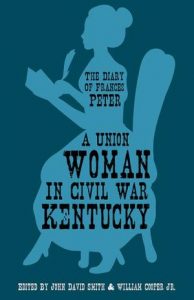Book Review: A Union Woman in Civil War Kentucky: The Diary of Frances Peter
Every time a new diary or memoir of someone who lived through the American Civil War is published, history comes incrementally closer to understanding the war that continues to define us as a nation. The 2021 publication of A Union Woman in Civil War Kentucky: The Diary of Frances Peter is just such a book. Edited by John David Smith and William Cooper, Jr., readers meet an unusual young woman living in Lexington, Kentucky–right in the middle of the border state uncertainty that was much of Kentucky’s Civil War experience.
Frances is an unusual diarist for many reasons. She was eighteen years old when the Civil War began. Her diary–the only published collection of a female Kentucky Unionist–starts in January 1862 and ends abruptly in April 1864. Frances’s view of the world was from the front window of her family home, facing what was known as the Little College Lot, now called Gratz Park. She was confined to her home by epilepsy, which took her life on August 5, 1864. Her father was a doctor, and her family was well-educated, which meant that Francis was not as isolated or shunned as many other epileptics. In fact, her understanding of the outside world and the war itself was very sophisticated. The social changes experienced by Lexington, a city in the middle of a unique aspect of the war, were carefully chronicled.
The diary begins with the Confederate invasion of Kentucky by General Braxton Bragg. It continues throughout the month-long occupation of Lexington by General Kirby Smith and includes much information about Kentucky’s expected “rally” for the Confederacy. Bragg (and the Confederate government) expected thousands of Kentuckians to appear in support of secession upon his entry into the state. This did not happen. Instead, Kentucky voted in a new governor and upheld the state’s independence. Any reader interested in Kentucky during this transitional time would do well to read Francis’s discussion of the matter. Her grasp of both politics and military maneuvering is unexpectedly excellent.
Another aspect of this diary concerns the proximity of the Peters’ house to that of Mrs. Henrietta Hunt Morgan, mother of Confederate Brigadier General John Hunt Morgan. He lived in Kentucky for most of his life and thoroughly identified with that state and with Louisville. Suffice it to say, there was no love lost between the families, especially after the start of the Civil War. Frances pulls no punches in her comments concerning the Morgans. Of John Hunt Morgan, she said: “His character here was always that of a gambler and libertine, and before this war, no gentleman in Lexington would associate with him.” Any chance Francis has to cast aspersions on the Morgans is taken, from the secret mail deliveries which were not so secret, to the unexplained falling of Mrs. Morgan’s conservatory porch ceiling. On one hand, Frances Peter is a sophisticated observer of politics and the war; on the other, she is a naive giggler at her neighbors and a dreamy teenager looking out “Ma’s window” at the handsome soldiers camped in the lot across the way.
The Diary of Frances Peter: A Union Woman in Civil War Kentucky ends abruptly. From Frances’s writing, readers would not know she was near death. She never complained that she could not attend concerts and fundraisers, work in the hospitals with her father, or even go much farther outside than the front porch. Instead, Frances reported events from what her sisters told her and embellished when she could. Her diary is one of the few publicly available that describes life in a border state. It is a valuable addition to the published diaries and letters currently available. The young author seems so fresh and natural that she could be a current neighbor, and even if readers are fans of John Hunt Morgan, it is fun to hear about him from Frances’s point of view. I recommend this book for border state studies–and a little gossip…
A Union Woman in Civil War Kentucky: The Diary of Frances Peter
Edited by John David Smith and William Cooper, Jr.
University Press of Kentucky, 2021, $19.95 paperback


Excellent post. I went to school at Centre College in Danville, Kentucky, just a few miles south of Lexington and Camp Nelson, and a few miles north of Perryville battlefield. It’s alumni include Lincoln’s first law partner, Stuart, Vice President and later Confederate Major General John Breckinridge, and John Marshall Harlan, the Elder. Danville was also the home of James Birney, the Liberty Party candidate in 1844. Kentucky was always very unique, if not quirky in its political structures, which were as much driven by personality as principle. The post shows this fascination with personal vignettes. So Lexington, and the contiguous Bluegrass region, though the wealthiest slaveholding region of the state, was a Whig, nationalist stronghold. John Breckinridge, a Democrat, was strongly admired by Henry Clay, but ironically won as a Democratic Congressman based on votes from outside the Bluegrass region. The state epitomized the brother against brother tragedy of the war.
For another diary by a Unionist woman from Kentucky, see _Josie Underwood’s Civil War Diary_, edited by Nancy Disher Baird and published in 2009. The Underwoods lived in Bowling Green.